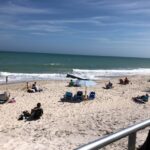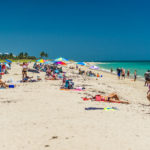VERO BEACH — If there is a father of Vero architecture, it may well be James Gibson.
John’s Island’s first resident architect, designer of the original Vero Beach Museum of Art and Riverside Theatre, dozens of office buildings and hundreds of homes, Gibson has left his subtle mark on the island’s most defining structures. From 1969 to today, his vision of orderly elegance has given the neighborhoods of Vero Beach’s barrier island a restrained and unobtrusive Georgian-style foundation within the capricious lushness of the subtropics.
It was Gibson, who, in the 45-acre Riverside Park, set the neo-classical museum and Riverside Theatre in the midst of sweeping live oaks, casting ordered lines amidst the wind-hewn landscape.
And when the town of Indian River Shores looked to implement strict building standards, aiming to avoid the high-rise clutter of coastal cities to the south, it turned to Gibson.
Now in his 60th year of practicing architecture, his newest gift to the community is not only a matter of the visual.
Gibson, an accomplished musician, long active on the boards of Vero’s top musical organizations, is donating his cherished 1923 nine-foot Steinway concert grand piano to the art museum. The piano will be featured next month in a concert by the Atlantic Classical Orchestra, long one of Gibson’s favorite causes.
The merging of Gibson’s gifts – the magnificent instrument he played for three decades, permanently ensconced in the serene space he designed, is sure to resonate through the island’s arts patrons as they hear it played for the first time in the museum’s Leonhardt Auditorium.
Though an ardent student of urban design, Gibson arrived in Vero knowing virtually nothing about the place he would call home for the second half of his long life. Gibson, then a recent widower, moved from Michigan with his three sons.
“Vero Beach was absolute news to me,” says Gibson. “It was very, very small.”
The most striking piece of architecture he found was the Ocean Grill. “I’ve always been intrigued by the pure imagination that went into that building,” he says. That wonderfully wavy floor. You almost get drunk just going to your table.”
Vero, a sleepy town of around 5,000, was just beginning to attract an eclectic island population of warmth-seeking retirees with tastes reflective of the urban centers where their fortunes had been made. All seemed intent on safeguarding the natural beauty of the place that added to the air of intimacy and privacy.
The idyllic landscape of the north barrier island had already caught the eye of Gibson’s neighbor in Grosse Pointe, Llwyd Ecclestone, who was about to begin developing John’s Island. Having finished his first luxury gated community in Palm Beach county several years earlier, Ecclestone hired Gibson to give a unique and unifying character to the first few hundred homes of the now iconic development.
Gibson considered Ecclestone’s target audience: affluent New Englanders who wanted to retire to an uncomplicated, leisure-driven, unpretentious life out of the limelight.
“I didn’t see anything in Florida that particularly appealed to me outside of the Spanish style. That was something that had been seen for years in Palm Beach.”
Long an admirer of Georgian architecture, with its classic lines and symmetry, Gibson felt that Vero’s northern-based winter residents would appreciate the familiarity of the design and “be very comfortable,” as Gibson put it.
“I was given carte blanche,” he says. “Georgian style is what I like to do. And so, that’s what I did.”
In addition to the estimated 600 homes, Gibson designed the gated community’s original golf and beach clubs, its 105-room hotel and 13 oceanfront condominiums and townhouses.
Over the years, Gibson’s buildings went beyond the borders of John’s Island to include homes in The Moorings and Windsor, the clubhouse at Sea Oaks, and dozens of commercial buildings along Central Beach.
After earning his architecture degree at the University of Michigan, Gibson spent the next two decades, at a large Michigan firm specializing in large commercial projects and general architecture. In his tenure, he worked on two major wings of the mammoth Detroit Institute of the Arts. He also worked on a building housing the Department of State in Washington, DC, as well as the Henry Ford Library and a number of buildings at Michigan State University.
When his wife died, his neighbor Ecclestone, who lived across the street from Gibson’s Grosse Pointe Italianate suggested he come make his mark on a little place called Vero Beach.
“When I first came here, everybody knew everybody else. It’s not a place where people are social climbers. Although many of them are very social, and very important, they don’t try to prove it. I find it a very graceful place to live.”
Most impressive was the way so many high achievers, now with time on their hands and a craving for cultural quality, seemed to make grand ideas come to fruition. Things seemed to sprout overnight, seemingly out of nothing more than idle chatter at a cocktail party, Gibson says.
Among the institutions to sprout in that manner: Riverside Theatre, built to Gibson’s pro-bono design in 1973.
“Once they decided to have that auditorium, they went out and started working for the money to do it. I’ve never seen anything happen so fast in my life. It seemed like within a month they raised what they needed.
“Or thought they needed,” Gibson adds. Originally built to stage performances by the Vero Beach Theater Guild, funds ran so low that they ran out of money before a curtain could be hung or purchase a piano for performances..
Gibson was instrumental in bringing in that Steinway too. He was president of the Vero Beach Concert Association when famed pianist Lili Kraus came to town to play, and afterward, gently complained about the instrument she had performed on. Gibson apologized, explaining that it was only a rental, that there were no funds to buy a piano. Kraus offered on the spot to return the next year and perform another concert to raise funds to buy the theater its own concert grand.
That Steinway, which Gibson and others selected from the Steinway showroom in New York, now belongs to Riverside.
Around that time, Gibson was shopping for his own piano, to replace the smaller parlor grand piano he kept in the living room of his John’s Island home. Along with two harps, the pianos were used for practice by musicians visiting Vero for various concerts from Gibson’s long tenure at the Concert Association, the Treasure Coast Opera Association, and later the Atlantic Classical Orchestra.
When he came across the Steinway concert grand, he knew he had to own it. The piano, built in 1923, had been built for the company’s concert division, one of several hundred stationed in cities around the country and used for concerts by top pianists. When at last the piano was retired after 44 years in use, it was bought by a New Orleans piano dealer, from whom Gibson acquired it in 1974.
For the next 14 years, he kept it at John’s Island, eventually moving it to Charleston, where Gibson has long kept a second home. After the death of his second wife, Susan Gibson, he moved to a smaller house in Charleston, with no room for the piano.
The 87-year-old piano is valued at $50,000 about half what a new concert grand costs today.






